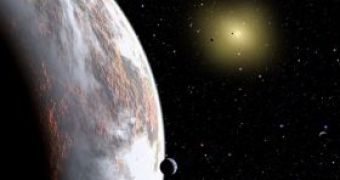I wonder when would the spree of lucky events that led to the appearance of life on Earth stop, as it seems more and more that we owe our existence to a chain of randomly occurring events. On the other hand, taking into consideration the large scale of the universe, with its billions and billions of stars and possibly planets, the possibility that intelligent life would appear and evolve on a single planet doesn't look so remote after all.
Nevertheless, scientists believe that we might be too lucky, as planet Earth is just large enough to sustain life. A slightly smaller Earth, and the planet would not present any plate tectonics. As we currently know, plate tectonics played a key role in shaping the geography of the planet and nonetheless in creating a hospitable environment for life.
Plate tectonics represent the upper crust of the Earth's surface, constantly moving a shifting as they float on an 'ocean' of magma. As heat escapes from the planet's massive core, it radiates towards to the upper layers through a convection process. But once it reaches the top layer, the Earth's solid crust, it finds itself trapped. Nevertheless, the surplus of energy must be ejected from the system through some method, thus it is converted into mechanical work which powers the movement of the plate tectonics.
Quite a crucial aspect, if you take into consideration the fact that the carbon dioxide, emitted on a regular basis by active volcanoes, is recycled from the different compounds it forms while being absorbed in natural carbon-dioxide sinks. As carbon dioxide is trapped in different rocks, such as carbonates, it would eventually be once again released back into the atmosphere, when these rocks are melted deep in the Earth's core.
One might add that the carbon dioxide gas is a greenhouse effect gas and it greatly influences today's weather. That's the whole point of it, Earth wasn't always as habitable as we view it today, not to say that carbon dioxide is also a key component in the photosynthesis process, which helps plants grow and provides animals with oxygen.
Furthermore, a larger planet two to ten times the current size of the Earth would also be friendly to life, but above that limit, the planet would have a gravitational field so powerful, that it would grow into a gas giant, and provide with enough material even a star. As expected, the team that conducted the study found that the more massive planets than Earth would naturally be more geologically active, while those slightly smaller, such as Venus, would be geologically inactive.
Let us remind you that Earth is the largest rocky planet in the solar system. Scientists argue that there is no wonder that all the other rocky planets don't present evidence of life. Planets larger than our own are regularly found throughout the Milky Way, but most of them present temperatures which are thought to be inhospitable.
We known such planets would be able to sustain atmospheres far denser than our own, due to their increased gravitational fields and geological activity that could release gases in volcanic eruptions. Nonetheless, the same gravitational effect could turn a visit to their surface into a relatively painful experience.

 14 DAY TRIAL //
14 DAY TRIAL //